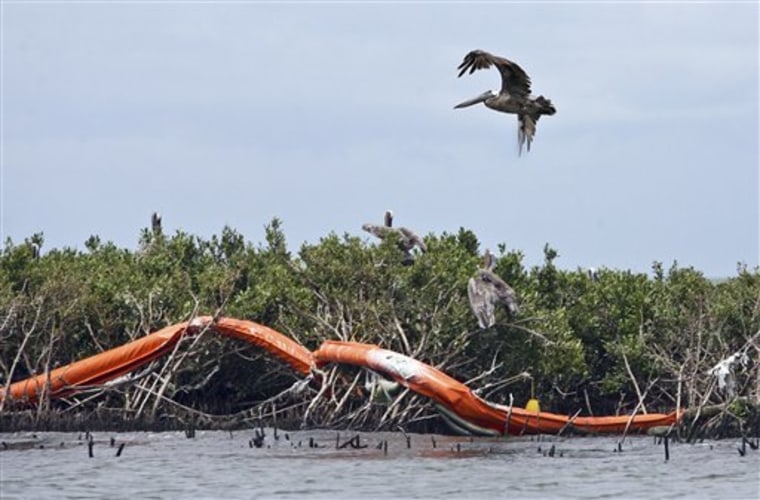The final plugging of the blown-out Gulf well has been delayed until September to allow replacement of a key piece of equipment, the U.S. official overseeing the oil spill reponse said Thursday.
BP had previously planned to complete its "bottom kill" procedure to seal the bottom of the well by mid-August.
Now, the procedure will likely begin "some time the week after Labor Day" holiday, which is on Sept. 6, retired Coast Guard Adm. Thad Allen said at a briefing Thursday.
The delay will allow BP engineers to replace the failed blowout preventer — a giant stack of pipes and valves that sit atop the Macondo well, a mile beneath the sea surface.
Allen said there had been intense discussion between the government and BP engineers over the chances that pressure might build in the well and how to proceed.
He said BP was told to carry out a pressure test to look for gases or anything else escaping from the well.
"Then we’re going to actually see if we can get a hold of the drill pipe that’s still left in the well and pull it out, so there’s not an obstruction. Then we’ve agreed we’re going to put a new blowout [preventer] on before we do the bottom kill," Allen said, speaking on msnbc's "Morning Joe" show.
"We're making sure that we put a stake in the heart of this monster," Allen added.
'We're not sure'
Asked where the oil had gone, he told Morning Joe: "I think the answer is, to some extent, we're not sure, but we do know certain things."
Allen added that they knew with "virtual certainty" that 827,000 barrels had been brought to the surface and the amount that was skimmed or burned was also known. The oil that evaporated or dispersed with chemicals has also been assessed, but this still leaves 26 percent of the oil.
Allen had previously said replacing the blowout preventer was the quicker of the two options engineers were considering to relieve pressure that may build up when the relief well intersects the blown-out well.
The other was to design a mechanism to attach to the current equipment.
BP's well blew out when the offshore drilling rig Deepwater Horizon exploded April 20, killing 11 workers and setting off one of the worst offshore oil spills in history.
A cap has kept oil from flowing for more than a month, but that's just a temporary solution. Mud and cement was later pumped in through the top of the well, significantly reducing the pressure inside it.
But the government believes the bottom kill procedure is necessary to declare the well dead once and for all.
Allen has said there were concerns that the cement may have trapped up to 1,000 barrels of oil in the space between the well pipe and the surrounding rock layers.
They want to make sure pumping in mud and cement through the relief well will not force that oil up, where it could leak into the sea.
Transocean accuses BP
Meanwhile, Transocean, the company which owned the Deepwater Horizon, is accusing BP of withholding what it describes as critical evidence needed to investigate the cause of the spill, according to a confidential internal document obtained by The Associated Press.
In a sternly worded letter to BP's attorneys, Transocean says the oil giant has in its sole possession information key to identifying the cause "of the tragic loss of eleven lives and the pollution in the Gulf of Mexico."
The letter adds that the company's refusal to turn over the documents has hampered Transocean's investigation and hindered what it has been able to tell families of the deceased and state and federal investigators about the accident.
"This is troubling, both in light of BP's frequently stated public commitment to openness and a fair investigation, and because it appears that BP is withholding evidence in an attempt to prevent any entity other than BP from investigating the cause of the April 20 incident and the resulting spill," the letter said.
Copies of the letter were also sent to government agencies and lawmakers investigating the spill's cause.
President Barack Obama sternly warned months ago that companies involved in the accident needed to work together and with the government on the investigation, saying: "I will not tolerate more finger-pointing or irresponsibility."
BP spokeswoman Elizabeth Ashford confirmed that company had reviewed the letter, but called its accusations misleading and misguided, particularly the charge that BP was withholding evidence.
Transocean said that certain limited information it has been able to retrieve from BP came only after the company reluctantly signed a confidentiality agreement.
"Ultimately, and despite our reservations, we agreed to BP's condition of secrecy because there is no other source of key well data," the letter says.
